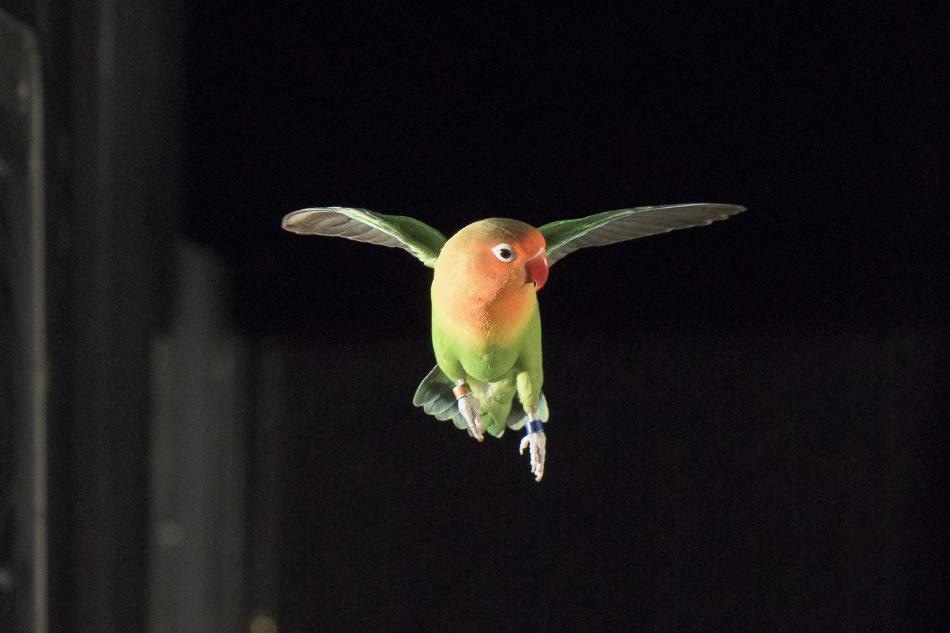Jul 10 2019
Scientists in the lab of David Lentink, assistant professor of mechanical engineering at Stanford University, investigated lovebirds flying in a crosswind tunnel which features customizable light and wind settings.
 Ferrari the lovebird during flight training in the bird wind tunnel in David Lentink's lab. (Image credit: L.A. Cicero/Stanford News Service)
Ferrari the lovebird during flight training in the bird wind tunnel in David Lentink's lab. (Image credit: L.A. Cicero/Stanford News Service)
Birds can naturally steer through strong crosswinds—and can do so in environments with low visibility, while pilots have to depend on advanced computations, radio signals, and tools to keep them on the right course during these difficult conditions.
The researchers were keen to understand how the birds achieve this feat. Details of the research have been published in the July 9th issue of the Proceedings of the National Academy of Sciences. This research could stimulate stronger and computationally effective visual control algorithms for autonomous aerial robots.
This is the first research of how birds position their bodies, heads, and necks to fly through extreme 45° crosswinds over short ranges—both in bright visual settings and in dark, cave-like settings, where a weak point of light is the only visual guiding light. To the scientists' amazement, the lovebirds were able to successfully navigate all environments well.
"It's amazing that lovebirds navigated 45-degree crosswinds even in our cave environment, because in their natural environment they fly in open habitats during the day," said Daniel Quinn, who worked as a postdoctoral fellow with Lentink and is currently an assistant professor at the University of Virginia. "Even well-trained pilots rely on runway lighting, radio beacons and guidance from air traffic controllers to land safely on windy nights."
The conditions we studied can cause spatial disorientation in pilots, yet the lovebirds aced their maneuvers in the dark as if there was no challenge. This was a big surprise to the entire team because we studied 'naïve' lovebirds. They were bred and kept in an indoor cage and had no experience with flying in the wind. Their ability may thus well be innate.
David Lentink, Assistant Professor of Mechanical Engineering, Stanford University
The scientists learned that lovebirds stabilize and fixate their gaze on the goal when navigating, and at the same time yaw their bodies into the crosswind. To keep on course requires them to actively twist their necks by 30° or more.
A computer-simulated model informed by the experimental data specified that, while neck control is active, body reorientation into the wind is realized passively. Additional tests with a basic mechanical bird model in a wind tunnel revealed how well it functions.
"Airplanes have a vertical tail to orient stably into the wind. We discovered why birds don't need one: their flapping wings don't only offer propulsion, they also orient into the wind passively like a weathervane" Lentink said.
However, this is just part of the story. Concurrently, the lovebirds actively contort their necks to position their heads toward the light beacon. The amount of neck twist then provides the relative wind angle with regard to their goal direction. This twist angle is all the lovebirds require to regulate their flight toward the beacon. While doing this, they steady their heads extraordinarily well.
Apparently, the direction of gravity sensed by the bird's vestibular system helps compensate for the missing wide-field visual horizon.
Daniel Quinn, Assistant Professor, University of Virginia
High-speed videos of the birds flying in the dark, recorded in infrared light, as well as the models describing the behavior revealed that birds do not need a wide-field visual horizon nor optic flow (motion of image intensity over the retina) to navigate in crosswinds.
This finding is opposing to several years of lab-based locomotion and neuroscience studies in still air that advocated that both were critical. The scientists still believe that clear visual information, when available, plays an important role in the way birds integrate all their sensory inputs, but the study revises the notion that it is vital.
This research was sponsored by the Human Frontier Science Program, Stanford Bio-X, the US Army Research Laboratory, a G.D. Fahrenheit scholarship, and the National Science Foundation. Other Stanford co-authors include Daniel Kress, Eric Chang, Andrea Stein, and Michal Wegrzynski.